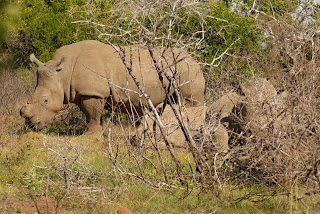 |
| male black rhino resting |
 |
| Azel explains how to "read" a midden |
really they can tell us so much more than just an address. They are more like Facebook pages or better yet, personal ads. SWF (Single White Female) Rhino.
They tell you whether the rhino is white or black. (White rhino dung is primarily grass because it grazes on the ground; Black rhino dung has twigs because it eats bushes.) It tells you whether the rhino in question is male or female. It can even tell you if she is looking for a relationship if the female is in estrus!!
One midden even gave us a forwarding address. It was originally a white rhino midden which was taken over by a black rhino. Down the way a little we found the new white rhino midden. With each midden we discovered, I would document the location and whether it was a white or black rhino on the rhino monitor official form.
 |
| white rhino family grazing and resting |
Whenever we actually found a rhino, I documented those too. Once again, we kept track of whether it was a black or white rhino, whether it was male, a female or a baby, where it was found and what it was doing - resting, grazing, moving.
 |
| male black rhino grazing in the bush |
 |
| mother and" baby baby" |
It was a great job!

No comments:
Post a Comment